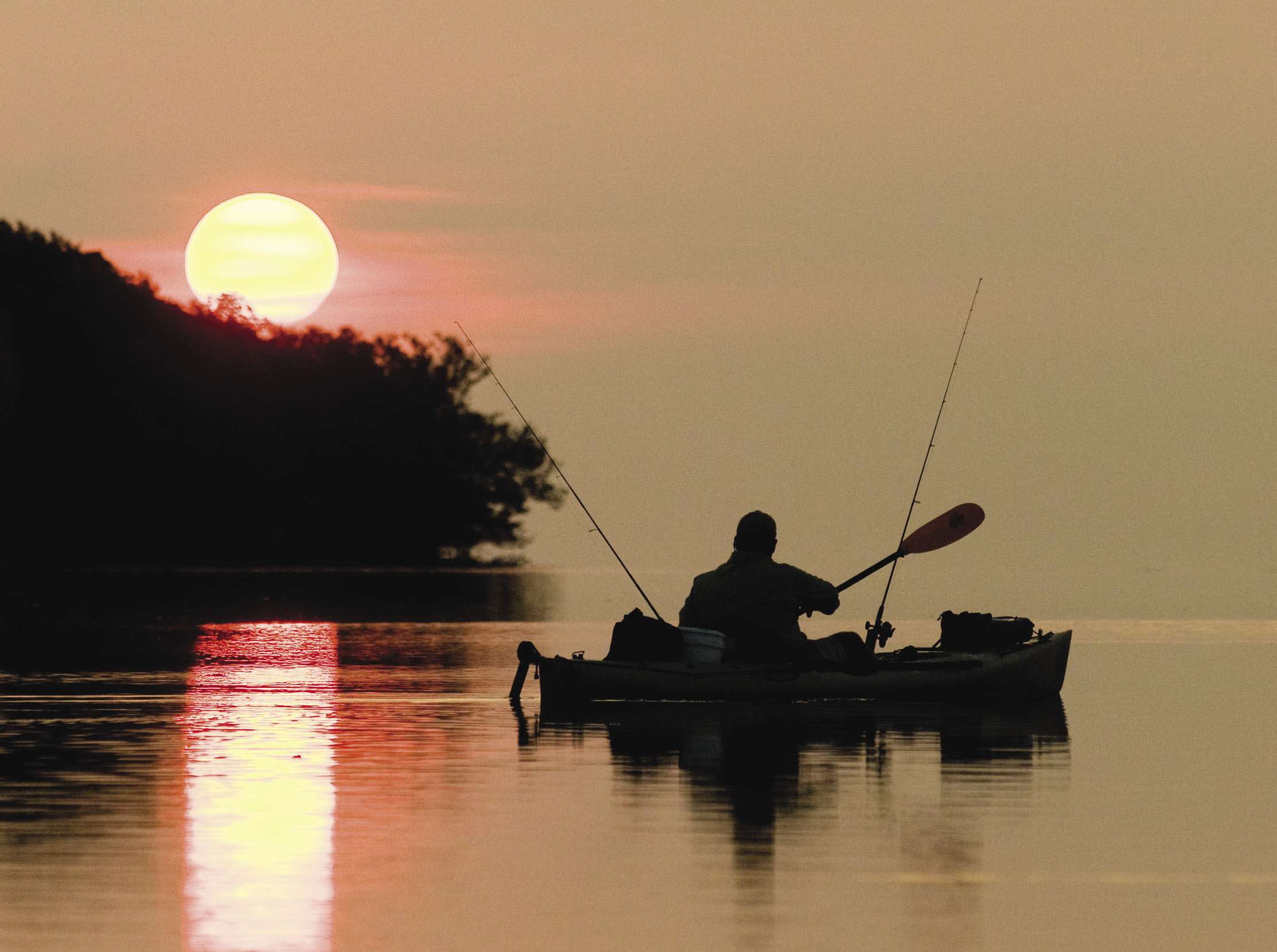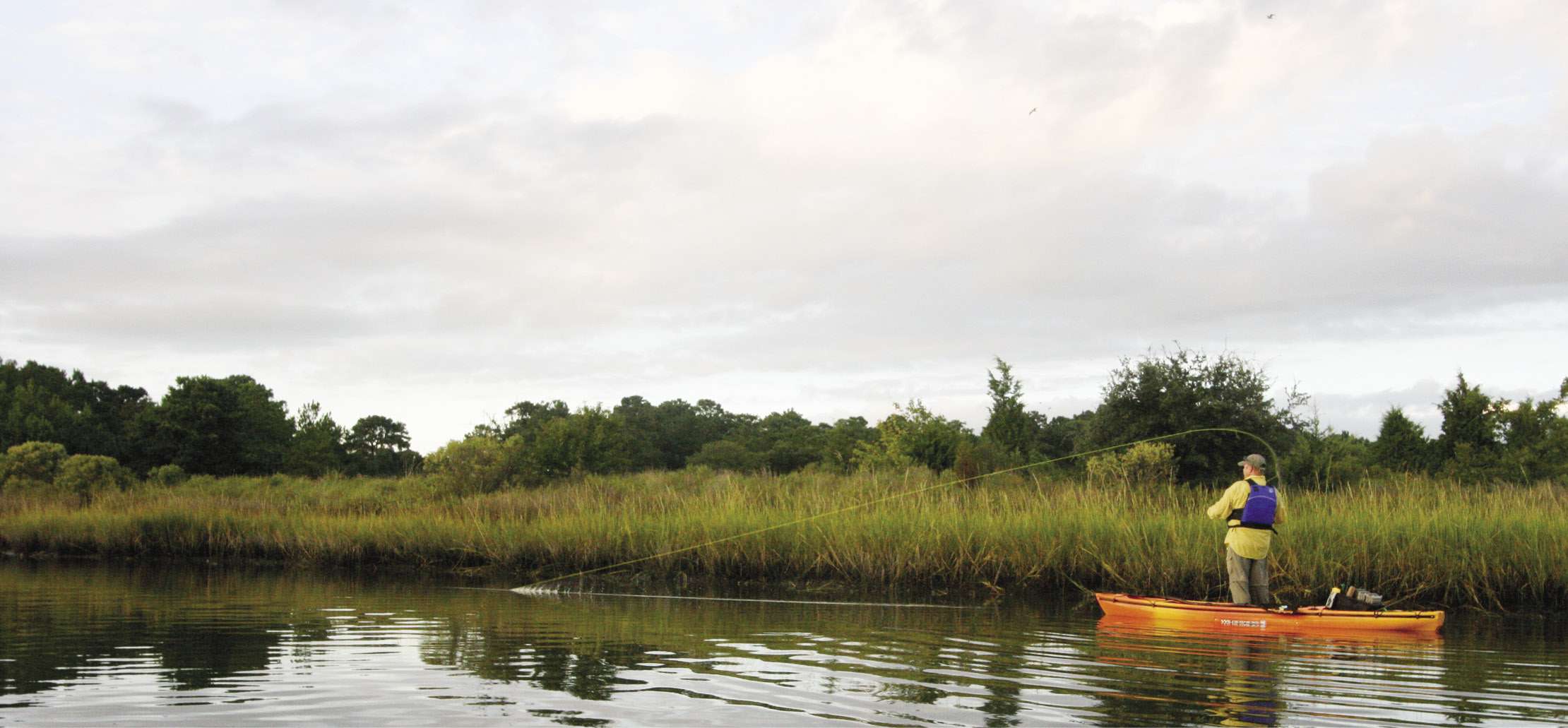
While gliding across a sandy-bottom flat, a redfish unknowingly waves you down with its tail. You’re able to get well within a cast’s length of the oblivious target, which is more focused on crushing oyster shells and eating the tender centers. A well-placed cast and a few twitches later, you’ve got a copper rocket burning up your drag. Snap a few photos, slide it back into the bluish-green water and stealthily move along to your next victim. It’s likely the next redfish won’t hear you coming, either.
PEACE ON THE WATER, PEACE OF MIND
David Blackwell, marketing and media manager for DOA Lures, prefers paddle power. It lets him bond and connect with his two kayak-crazy sons while taking in Florida’s unspoiled coast.
“In this day and age, you don’t want your kids getting 10 feet away from you in the mall, but out on the flats, my boys can be 50 yards away and everything’s fine,” he says. “They can explore and gain a bit of independence without me worrying.
“Kayaks offer a much more natural way to fish. You just glide out of life and into the wilderness,” he says. “It really gives you a degree of freedom that you don’t get with a big outboard and the headaches of launching a boat and worrying about a dozen different things.”
Jerry McBride, outdoors journalist and kayak guru, agrees.
“I haven’t found a downside to kayak fishing yet,” McBride says. “I haven’t found any other way that even comes close to the number of fish I can catch. But catching fish almost becomes secondary to the feeling of freedom I get when I’m out there. The simplicity is wonderful.”
McBride sold his powerboat years ago and now travels from his Jensen Beach, Fla., home to boating and fishing trade shows to give seminars on ’yak fishing. McBride credits the kayak resurgence to affordability, convenience and simplicity.
“I don’t mess with boat ramps, and I’m on the fish before the boaters ever get near them,” he explains. “The other day I was working a place boats couldn’t access and got 11 pompano in 15 casts. The guys in the boat didn’t catch much of anything. In a kayak, you can slip through holes in the mangroves that big boats would have to run two miles to get to.”
McBride says sitting on top of a kayak affords him a greater appreciation of coastal areas from Florida to Texas to New England.
“When paddling at 3 or 4 knots, you can’t help but notice things you’d fly right over when buzzing around at 50 miles per hour,” he says. “You’re much more aware of your surroundings, and the whole experience is more enjoyable.
“You can also get closer to the fish. It’s not uncommon to drift up next to a 30- or 32-inch trout or 45-inch snook and eyeball each other without spooking him. If I play my cards right, I can get him to bite every time.”
Blackwell agrees.
“You notice a school of rays, baitfish you never would’ve seen, and your kids enjoying themselves in nature when otherwise you’d be worrying about them falling out of a boat while on plane,” he says.
For those accustomed to the run-and-gun fishing style, the slower speed of the kayak is often a welcome change of pace.
“To me, drifting around and paddling in a kayak is strangely more exhilarating. I love the silence it offers,” McBride explains. “Since I’ve become more experienced in a kayak, 12 hours of paddling leaves me feeling refreshed. Conversely, after standing on a fiberglass deck for just four hours, my body is hating me.”
To those who do not consider fishing a sport, adding a kayak to the mix may make them reconsider.
“A lot of people get into kayaks for the exercise,” he explains. “As they fish from them more and more, they realize their fish catches go up as well as their stamina. After a while, the fishing is a bonus to all the paddling you get to do.”

SKINNY WATER ON A SMALL BUDGET
Kayaking is as good for your mind and body as it is for your wallet.
McBride recalls that in the first wave of kayak popularity, boaters were strapping ’yaks to their bay boat, running to a fishy area, then slipping onto the kayaks to actually fish. They offered a better, stealthier approach to fish. Cost was an afterthought.
“They felt like the kayak was a more efficient machine than the boat,” he says. “That was the original reason people got into them, but now a lot of folks are forgoing the boat and getting right into a kayak.”
If you’re interested in taking the kayak plunge but still can’t take the initial investment hit, try renting a boat from one of the many vendors along the coastal United States. Boats can be had by the hour or day.
ADDITION BY SUBTRACTION
McBride says taking away the complexities of modern fishing makes for a more pleasant — and fish-filled — experience on the water. Kayaks let you avoid ramp fees, gas pumps and licensing fees. In short, you’re avoiding the headaches and bills associated with fishing the flats.
McBride reasons that if you’re preparing to fish out of a kayak, you have to plan more carefully than when skiff fishing. If you fail to plan properly when kayak fishing, you don’t have the luxury of firing up the big motor and moving 10 miles. You need to know about the tide, water temperature and seasonal habits of your quarry. Learning these things will make you a better angler.
McBride goes on to say that this forced preparation will improve your understanding of the sport and increase your success.
“There is no difference between good skiff technique and good kayak technique. You don’t alter fishing technique, no matter what platform you’re on. If you do it right, you can get on fish much more easily and have a much more rewarding, healthy and therapeutic time doing it.”
